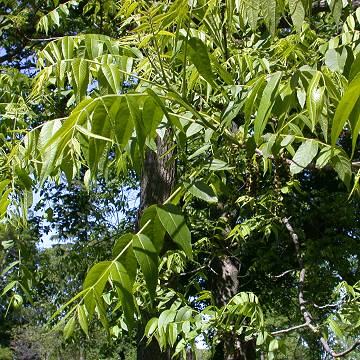

Juglans nigra - (image 1 of 7)
Taxonomy
Family: Juglandaceae
Habitat
Woodland, savanna. Lowland woods along streams. Fire adapted
Associates
Acer saccharum, Carya cordiformis, Carya ovata, Celtis occidentalis, Cryptotaenia canadensis, Erythronium albidum, Fraxinus americana, Geranium maculatum, Geum canadense, Hydrophyllum virginianum, Isopyrum biternatum, Parthenocissus quinquefolia, Polygonatum canaliculatum, Polygonum virginianum, Quercus rubra, Tibes missouriense, Rubus occidentalis, Sambucus canadensis, Sanicula gregaria, Tilia americana, Trillium recurvatum, Ulmus americana, Ulmus rubra.
Distribution
Most of the US except for some western states.
Morphology
Large tree, to 130' high. Leaves alternate, pinnate compound with 15-23 leaflets, the terminal leaflets often reduced or missing; leaflets lanceolate, irregularly serrate, fragrant when broken. Stems stout, gray downy to smooth and reddish buff; twigs with light brown pith; bark deeply furrowed, dark gray to blackish. Flowers monoecious, green to brown; the male flowers with 20-30 stamens, in catkins 5-10 cm long; female flowers in erect clusters of 1-4. Fruit a fleshy drupe with a hard, stony endocarp; kernel strong flavored, oily.
Notes
Flowers late April to early June
Wetland indicator: Facultative upland
Highly valued for it's wood, it is reputed to be the target of considerable poaching in some areas. The roots produces a substance called juglone that inhibits the growth of many species of plants, including walnut seedlings. Can be mistaken for sumac when young.
References
Dirr, Michael A. 1998. Manual of Woody Landscape Plants:
Their Identification, Ornamental Characteristics, Culture, Propagation and Uses.
5th ed. Champaign, Illinois: Stipes Publishing L.L.C.
|
Michael Hough © 2005 |